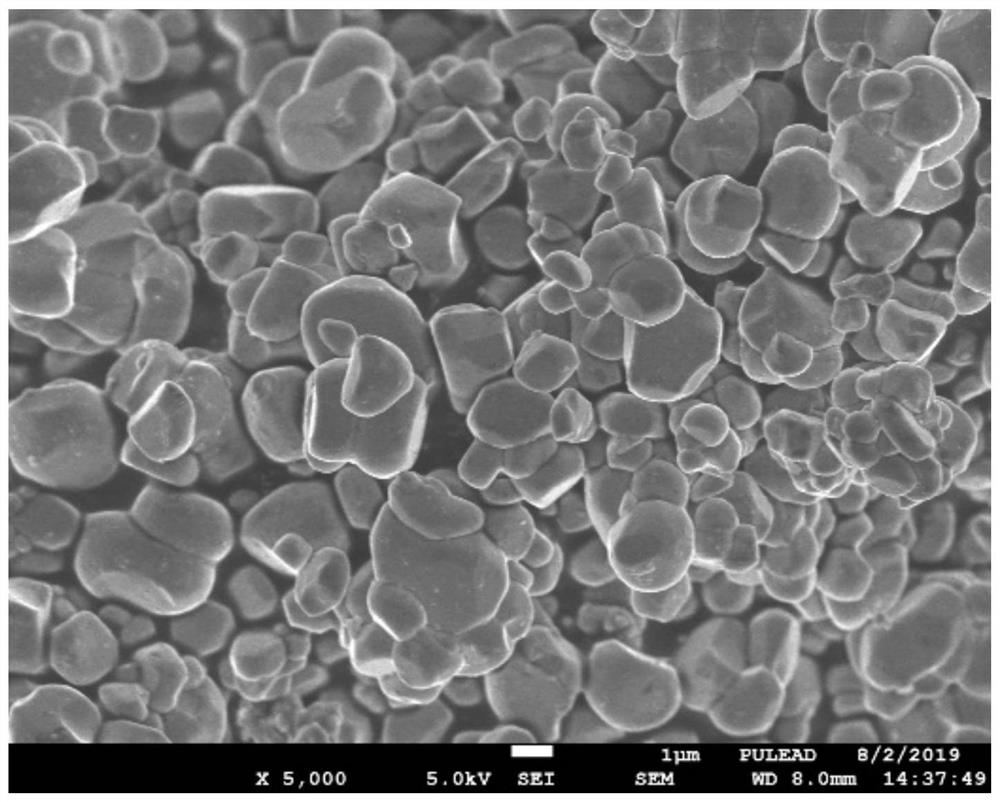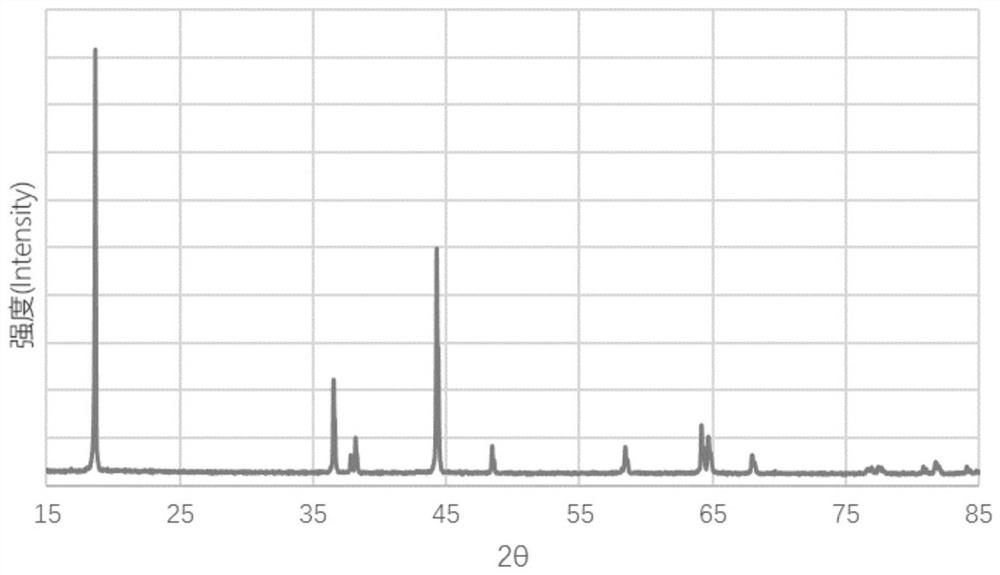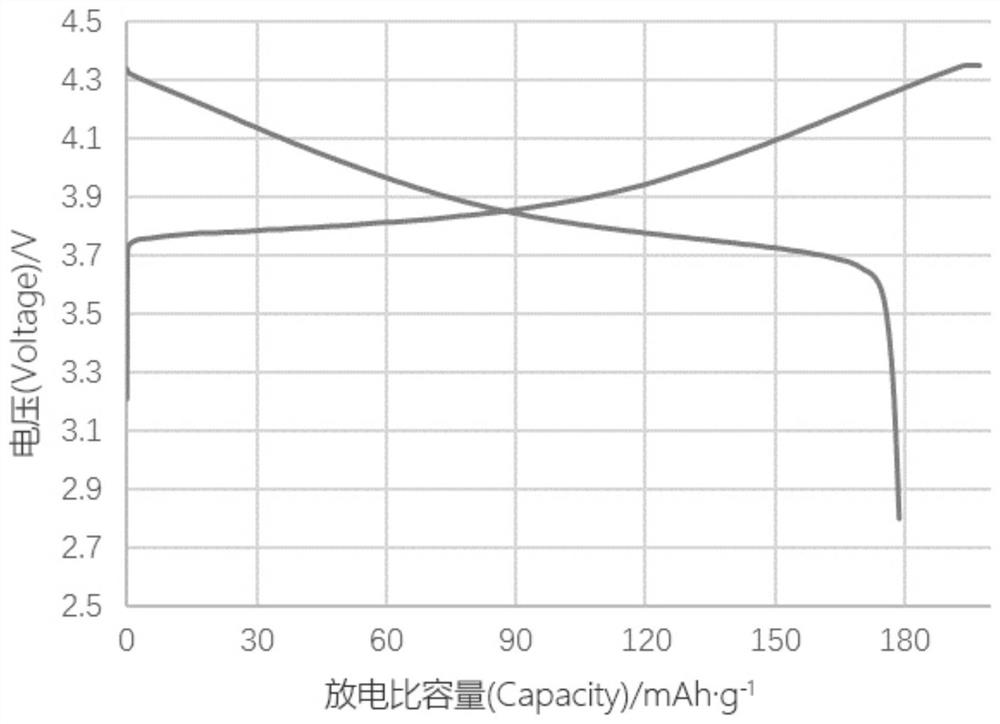Single-crystal ternary positive electrode material, preparation method thereof and lithium ion battery
A technology for lithium-ion batteries and positive electrode materials, which is applied in battery electrodes, secondary batteries, chemical instruments and methods, etc., can solve the problems of low cobalt content, increased lattice oxygen defects, and increased lithium-nickel mixed discharge.
- Summary
- Abstract
- Description
- Claims
- Application Information
AI Technical Summary
Problems solved by technology
Method used
Image
Examples
Embodiment 1
[0040] (1) Select the precursor Ni with a nickel-cobalt-manganese molar ratio of 55:05:40 and a D50 of 4 microns 0.55 co 0.05 mn 0.40 (OH) 2 , after mechanical activation, its D50 is controlled at 2.9 microns, and then it is uniformly mixed with lithium hydroxide and strontium carbonate. The ratio of the total molar number of transition metals used is a molar ratio of 3:1000;
[0041] (2) The mixed powder is sintered in an air atmosphere at a sintering temperature of 980 ° C, and the sintering is completed for 10 hours, and finally the ternary cathode material Li 1.06 Ni 0.55 co 0.05 mn 0.40 Sr 0.003 o 2 .
[0042] Utilize the scanning electron microscope to detect and obtain the scanning electron micrograph (as shown in Fig. figure 1 ), the prepared ternary material was detected by X-ray diffraction, and the XRD diffraction pattern of the material was obtained (such as figure 2 ), at the same time, the specific unit cell parameters of the material were obtained (s...
Embodiment 2
[0047] (1) Select the precursor Ni with a nickel-cobalt-manganese molar ratio of 55:05:40 and a D50 of 3 microns 0.55 co 0.05 mn 0.40 (OH) 2 , after mechanical activation, its D50 is controlled at 2.5 microns, and then it is uniformly mixed with lithium hydroxide and strontium carbonate. The ratio of the total moles of transition metals used is a molar ratio of 2:1000;
[0048] (2) The mixed powder is sintered in an oxygen-enriched atmosphere at a temperature of 980°C, and the sintering is completed for 10 hours, and finally the ternary cathode material Li 1.06 Ni 0.55 co 0.05 mn 0.40 Sr 0.002 o 2 .
[0049] Using X-ray diffraction, the specific unit cell parameters of the material were detected (see Table 1).
[0050] Using the same button battery manufacturing method and test system as in Example 1, the first discharge specific capacity of the material at a current density of 0.1C is 177.2mAh / g, and the 50-cycle cycle retention rate of the material at a current den...
Embodiment 3
[0052] (1) Select the precursor Ni with a nickel-cobalt-manganese molar ratio of 55:05:40 and a D50 of 5 microns 0.55 co 0.05 mn 0.40 (OH) 2 , after mechanical activation, its D50 is controlled at 2 microns, and then it is uniformly mixed with lithium hydroxide and strontium carbonate. The ratio of the total molar number of transition metals used is a molar ratio of 1:1000;
[0053] (2) The mixed powder is sintered in an air atmosphere at a sintering temperature of 900 °C, and the 30h heat preservation sintering is completed to finally prepare the ternary cathode material Li 1.06 Ni 0.55 co 0.05 mn 0.40 Sr 0.001 o 2 .
[0054] Using X-ray diffraction, the specific unit cell parameters of the material were detected (see Table 1).
[0055] Using the same button battery manufacturing method and test system as in Example 1, the first discharge specific capacity of the material at 0.1C current density is 176.5mAh / g, and the 50-cycle cycle retention rate of the material at...
PUM
| Property | Measurement | Unit |
|---|---|---|
| Diameter | aaaaa | aaaaa |
Abstract
Description
Claims
Application Information
 Login to View More
Login to View More - R&D
- Intellectual Property
- Life Sciences
- Materials
- Tech Scout
- Unparalleled Data Quality
- Higher Quality Content
- 60% Fewer Hallucinations
Browse by: Latest US Patents, China's latest patents, Technical Efficacy Thesaurus, Application Domain, Technology Topic, Popular Technical Reports.
© 2025 PatSnap. All rights reserved.Legal|Privacy policy|Modern Slavery Act Transparency Statement|Sitemap|About US| Contact US: help@patsnap.com



